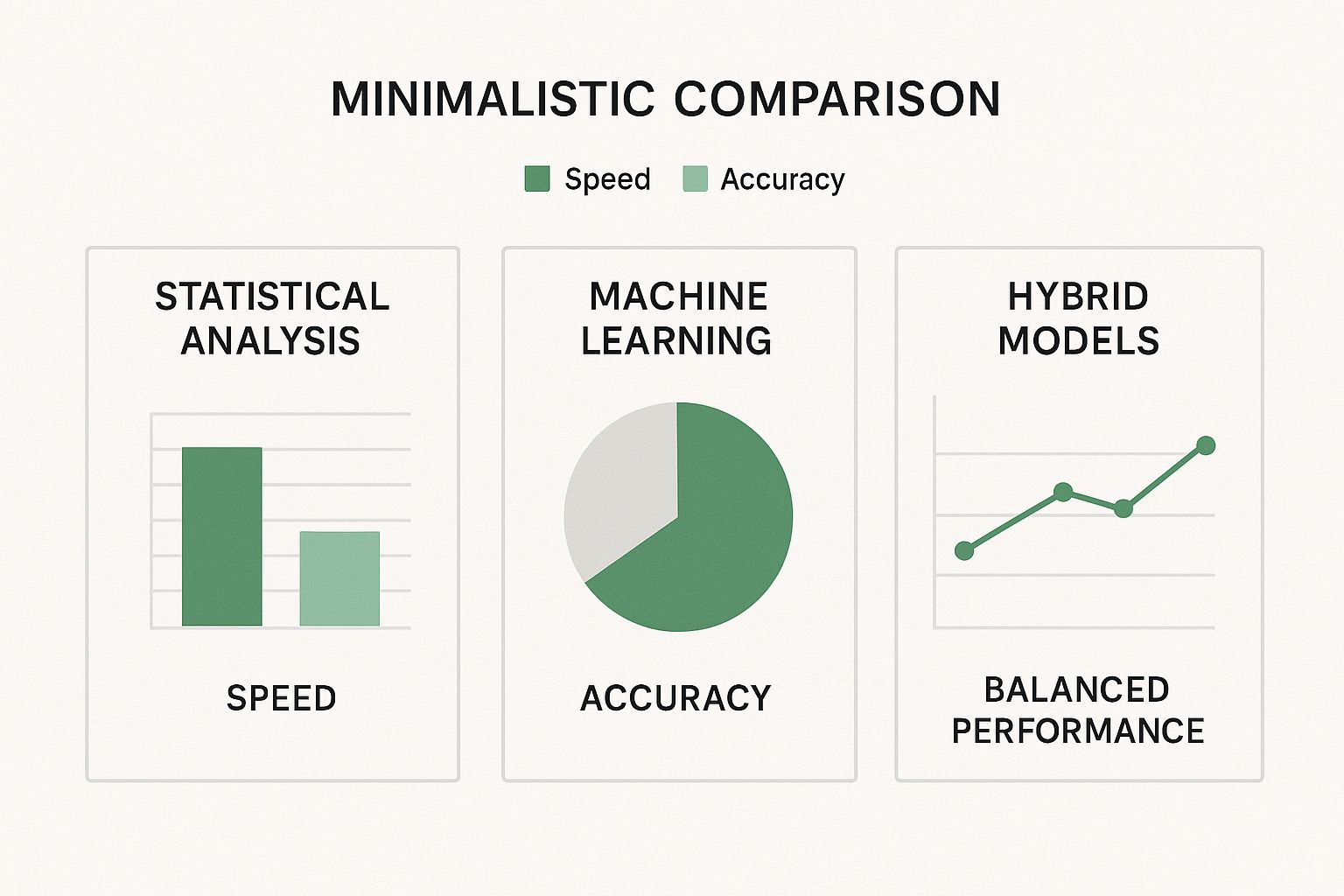
How to Make AI Writing Undetectable: Your Step-by-Step Guide
June 10, 2025
What You're Really Up Against (Detection Technology Decoded)
Making AI-generated writing undetectable isn't about tricks. It's about understanding how detection tools work. These tools, like GPTZero and Originality.AI, aren't magic. They're built on algorithms that analyze text, searching for patterns that reveal a non-human writer. Think of them as digital detectives looking for clues.
These algorithms are designed to identify specific markers. One key pattern is perplexity. This measures how predictable the text is. AI-generated content often has low perplexity because it relies on predictable word choices and sentence structures. Human writing, on the other hand, tends to be more complex and less predictable.
Decoding Perplexity and Burstiness
Another important factor is burstiness. This refers to the variation in sentence complexity within a piece of writing. AI tends to produce text with uniform burstiness, while human writing naturally fluctuates between simple and complex sentences. This creates a rhythm that engages readers.
Detection tools also flag overly formal or repetitive language, common traits of AI-generated text. That's why injecting personality and a conversational tone into your writing is crucial. It helps your content resonate with readers and bypass those robotic red flags.
The demand for tools that make AI writing undetectable has surged along with the rise of AI itself. Industry reports from 2025 show that 83% of companies worldwide consider AI a top priority. Content creation is a major application. Tools like GPTZero and Originality.AI have become popular, but even these platforms face challenges when users strategically refine their AI-generated content. Discover more insights about AI detectors.
Exploiting the Vulnerabilities
Even advanced detection systems have weaknesses. They can struggle with nuanced language, figures of speech, and emotional depth — elements characteristic of human writing. Understanding these vulnerabilities is key to creating AI content that bypasses detection. You might also be interested in: How to master Turnitin.
Simply running text through a paraphrasing tool isn't enough. A more strategic approach is necessary, one that considers the underlying principles of detection algorithms. This understanding empowers you to use AI writing tools effectively, crafting authentic content. This knowledge will transform your approach to making AI writing undetectable.
Crafting Prompts That Sound Human From the Start

The secret to AI writing that goes undetected lies in the prompt. Professionals consistently bypassing AI detection systems understand effective communication with these tools. They go beyond simply entering a keyword and hitting "generate." They craft prompts designed for natural-sounding content from the beginning.
This involves incorporating specific language patterns, conversational cues, and stylistic elements. It's about giving the AI the right ingredients to create something authentic.
The Power of Context and Personalization
Adding emotional context, personal perspectives, and even intentional imperfections dramatically improves AI-generated text. It's like giving the AI a persona. Instead of requesting an article about "dog training," instruct the AI to write from the perspective of a seasoned dog trainer sharing tips. This immediately adds authenticity and engages the reader. You might be interested in: How to master humanizing text from ChatGPT.
Furthermore, incorporating anecdotes, specific examples, or humor enhances the human-like quality. This nuanced approach goes beyond robotic information, creating content that connects with readers. Your prompts should be detailed and descriptive, providing the AI with the context it needs to generate truly engaging content.
Fine-Tuning For Authenticity
Surprisingly, even small prompt adjustments significantly impact the detectability of AI-generated writing. Experts estimate that simple prompt tweaks, like adding colloquialisms, can fool detection tools 80-90% of the time, according to professionals involved in the New York State Bar AI Task Force. This highlights experimenting with phrasing and keywords in your prompts.
Understanding your target audience is also crucial. Tailoring prompts to their language and style preferences ensures the AI generates resonant content. This makes the content more engaging and less likely to be flagged. Read also: How to master humanizing AI text. This allows the AI to adopt a genuine voice, blurring the lines between machine-generated and human-written text.
Proven Humanization Techniques That Actually Work

Turning robotic AI text into engaging, human-quality content takes more than just finding synonyms. It requires specific humanization techniques that can even outsmart sophisticated AI detection software. This involves adding authentic personality, emotional depth, and a natural, conversational flow to make your writing resonate with readers. The goal is to make them forget they're even reading AI-generated text.
Injecting Personality and Emotional Resonance
One key difference between AI and human writing is emotional depth. AI struggles to replicate the nuances of human emotion, often creating flat, impersonal text. But by strategically adding emotional context, personal stories, and even intentional imperfections, you can significantly improve your AI-generated content. Instead of just stating facts, try weaving in personal experiences or opinions for a more relatable and engaging narrative. For more tips, check out this helpful resource: How to master humanizing AI text.
Varying sentence structure and length is also crucial for mimicking the natural rhythm of human writing. AI tends to produce repetitive sentence patterns, a clear sign of machine-generated content. To avoid this, incorporate a mix of short, punchy sentences and longer, more complex ones to create a dynamic and engaging flow. This mirrors how people naturally speak and think.
Mastering Conversational Flow and Natural Imperfections
Another giveaway of AI-generated content is its overly formal and predictable language. To counter this, focus on a conversational flow. Use contractions, colloquialisms, and informal expressions. Don't be afraid to add humor or personal asides for a more authentic feel. This makes your writing more relatable and less robotic.
Embrace natural imperfections, too. Human writing is rarely flawless. We all make grammatical errors, use slang, and sometimes ramble. Strategically incorporating these imperfections can actually make your AI-generated content feel more human. This might mean adding a few well-placed typos or using sentence fragments for a sense of spontaneity. Just remember to strike a balance – don't overdo it.
Refining Your Content Through Strategic Editing
Finally, remember the power of strategic editing. After generating your initial draft with AI, take time to carefully refine it. Look for repetitive phrasing, awkward sentences, and any remaining robotic language. This crucial step ensures your content not only bypasses AI detection but also reads naturally and engages your target audience. By using these humanization techniques, you can transform your AI-generated content from robotic to relatable, engaging, and ultimately, undetectable.
Advanced Editing Strategies to Beat Detection Systems

This infographic illustrates the core traits of various AI detection models: statistical analysis, machine learning, and hybrid models. Notice how statistical analysis prioritizes speed, while machine learning values accuracy. Hybrid models, as the infographic shows, aim for a balance of both. Understanding the type of detection model you're facing can significantly inform your editing approach.
Basic humanization techniques offer a good starting point, but truly undetectable AI writing demands more advanced editing. This goes beyond simple paraphrasing and involves restructuring your content for a more natural reading experience. This section reveals professional strategies to make your AI writing undetectable.
Mastering Sentence Complexity and Paragraph Flow
One key element of human writing lies in varied sentence complexity. AI often generates uniform sentences, a clear indicator of machine origin. To counter this, strategically mix short, impactful sentences with longer, more complex ones. This mirroring of natural human thought rhythms makes your writing less detectable.
Good paragraph flow is also essential. Each paragraph should have a clear topic sentence and transition smoothly to the next. Utilize transitional phrases like "Furthermore," "However," and "In contrast" to build logical bridges between ideas. This creates a guided reading experience, avoiding the choppy feel characteristic of AI-generated text.
Eliminating Linguistic Fingerprints
AI detection algorithms are trained to identify specific linguistic fingerprints. These include repetitive phrasing, predictable sentence structures, and a lack of tonal variation. Removing these fingerprints is crucial for creating undetectable content. Sentence reconstruction, completely rewriting sentences while preserving the core meaning, is an effective strategy.
Synonym variation is another helpful tool. However, avoid simply swapping words at random. Carefully select synonyms that precisely reflect the intended nuance and fit seamlessly within the context. This attention to detail helps avoid awkward phrasing and maintains clarity.
To illustrate the differences between AI writing and human writing, and the necessary editing actions, consider the following table:
AI Writing Patterns vs. Human Writing Characteristics
A detailed comparison showing the key differences between typical AI-generated content patterns and natural human writing characteristics that can help guide your editing process
| AI Writing Patterns | Human Writing Characteristics | Editing Action Required |
|---|---|---|
| Uniform sentence structure | Varied sentence length and complexity | Restructure and combine sentences; introduce variety |
| Repetitive phrasing | Diverse vocabulary and phrasing | Employ synonyms and rephrase content |
| Lack of tonal variation | Consistent and engaging tone | Review for tone shifts and adjust accordingly |
| Predictable sentence structure | Natural transitions and flow | Introduce transitional phrases and vary sentence beginnings |
| Abrupt topic changes | Smooth transitions between paragraphs | Use connecting phrases and ensure logical flow |
This table summarizes key areas where AI writing often falls short and highlights the editing required to make it more human-like. Focus on varying sentence structures, enriching vocabulary, and maintaining a consistent tone.
Embracing Strategic Imperfections and Tonal Consistency
While eliminating obvious AI markers is crucial, strategically incorporating imperfections can paradoxically enhance authenticity. Human writing isn't flawless. We make occasional grammatical slips, use slang, and sometimes digress. Subtly integrating these imperfections can create a more organic feel.
Maintaining tonal consistency is equally vital. AI can sometimes shift tones abruptly, making for a disjointed reading experience. Carefully examine your content for tonal inconsistencies and ensure a consistent voice throughout. This creates the impression of a single, human author. Ultimately, making AI writing undetectable is about replicating the nuances of human expression.
Smart Tools and Software That Do the Heavy Lifting
Let's explore the world of humanization platforms. These tools can help make AI-generated writing sound more natural. But, not all platforms are equal. We'll look at the truly useful tools and skip the time-wasters. This includes exploring both free and paid options. We'll also discuss when each type is most effective and how combining tools can boost your results.
Beyond Basic Paraphrasing
These platforms go beyond simple paraphrasing tools like QuillBot. They address the specific patterns that AI detection software looks for. Think of it this way: paraphrasing is like changing your clothes, while humanization is a complete makeover. Paraphrasing might fool a casual glance, but true humanization fools even the closest inspection.
This means understanding how these platforms work. We'll examine their underlying mechanics and how they differ from just swapping synonyms. This deeper understanding helps you use these tools effectively without sacrificing content quality.
Choosing the Right Tool for the Job
Different tools excel at different tasks. Some create natural-sounding dialogue. Others shine with academic writing. Using real-world examples and user feedback, we’ll see which tools perform best for specific content types.
The following table helps compare some of the top AI humanization tools. It highlights key features, pricing, and how effective they are with different content types.
Top AI Humanization Tools Comparison
Comprehensive comparison of leading AI humanization tools, their features, pricing, and effectiveness rates for different content types
| Tool Name | Key Features | Pricing | Effectiveness Rate | Best Use Case |
|---|---|---|---|---|
| Natural Write | One-click humanization, AI detection, privacy-focused | Free | High | Refining AI-generated drafts for various content types |
| Wordtune | Rewriting, tone adjustment, grammar correction | Freemium | Medium | Improving clarity and style in various writing tasks |
| Grammarly | Grammar and spell check, plagiarism detection, style suggestions | Freemium | Low (for humanization specifically) | Primarily for grammar and plagiarism checks, less effective for comprehensive humanization |
This table offers a quick comparison. Remember, effectiveness can vary. It's always best to test a tool with your specific content. Don't forget to check the humanized output. Before publishing, make sure it not only bypasses AI detection but also maintains quality. Look for clarity, readability, and accuracy.
Using AI humanization tools effectively lets you create authentic and engaging content. By choosing the right tools and workflows, you can harness the power of AI without losing quality.
Testing Your Content Like a Pro

Humanizing AI-generated content is essential. But how do you know if it truly passes as human-written? Rigorous testing is key to making AI writing undetectable. This section will guide you through building a reliable testing process.
Building a Multi-Platform Testing Strategy
Testing your content with just one AI detector isn't enough. Different platforms use different algorithms. This means one detector might miss what another catches. It's like getting a second opinion from a doctor.
A truly comprehensive testing process involves using multiple detectors. This allows you to identify potential issues early on. Using multiple platforms provides a more complete picture of your content's detectability. Some popular options include GPTZero, Originality.AI, and the free AI detection tool from Natural Write.
Interpreting Confidence Scores
Most AI detectors provide a confidence score. This score indicates how certain the detector is that the content is AI-generated. Understanding these scores is crucial.
A high score doesn't automatically mean your content is AI-written. Conversely, a low score isn't a guarantee of undetectability. Each platform has its own scoring system. A "high" score on one platform might be "medium" on another. Learn the nuances of each platform. This will help you accurately interpret the results and make informed decisions.
Free vs. Premium Testing Options
You'll find both free and premium AI detection tools available. Free tools are great for quick checks and getting started. However, premium tools often offer more in-depth analysis and additional features. These often include things like plagiarism detection.
Natural Write provides a free AI detection check. This is excellent for quick assessments. For professional use, consider investing in a premium tool like Originality.AI. Premium tools offer more comprehensive analysis and advanced features.
Establishing Confidence Thresholds and Ongoing Quality Assurance
It's important to establish your own confidence thresholds. Determine what level of AI detection probability is acceptable for your needs. This might vary depending on the content's purpose and your target audience. Academic writing, for example, might require a higher human score than a casual blog post.
Test your content regularly throughout the writing process. Don’t wait until the final draft. Testing at different stages helps identify and address potential issues early. This saves you time and effort in the long run. Regular testing also allows you to refine your humanization techniques and improve your content's overall quality. This proactive approach to quality assurance is essential for consistently producing undetectable, high-quality AI content.
Keeping Quality High While Staying Undetectable
Making AI-generated content undetectable is only part of the equation. The real challenge? Maintaining high quality, accuracy, and genuine value while ensuring it's indistinguishable from human-written text. This section focuses on achieving that crucial balance.
Fact-Checking and Maintaining Accuracy
One vital aspect often overlooked is fact-checking. AI can generate text rapidly, but it doesn't inherently grasp the concept of truth. It's essential to verify all information, particularly statistics and specific claims. Inaccurate content, even if undetectable, erodes credibility. Think of it like this: undetectability is the polish, but accuracy is the substance.
Maintaining SEO value is another key consideration. While humanizing your content, avoid over-editing keywords or fundamentally altering the core message. Strategic keyword placement remains crucial for online visibility. Aim for a balance between natural language and effective SEO practices.
Enhancing Readability Through Humanization
Humanization shouldn't hinder readability – it should enhance it. AI-generated text can sometimes be dense and overly formal. By incorporating conversational elements, varying sentence structures, and adding personal touches, you significantly improve readability. It's like adding spices to a dish – they enhance the flavor without changing the core ingredients.
Consider these best practices for maintaining quality:
Focus on Clarity: Ensure your message is clear and concise. Avoid jargon and overly complex sentences.
Maintain a Consistent Tone: Establish a tone early on and stick to it throughout the entire piece. This creates a unified voice and improves readability.
Engage the Reader: Use storytelling, real-world examples, and thought-provoking questions to create a more engaging experience.
Quality Control for Undetectability and Excellence
A robust quality control process is paramount. This involves checking for both undetectability and overall content quality. Use several AI detection tools like Natural Write to test for undetectability. Also, have a human editor review the content for clarity, accuracy, and overall quality. This dual approach ensures your content meets both technical and creative benchmarks.
Different content types demand different approaches. Technical writing prioritizes accuracy and clarity, while marketing copy emphasizes persuasion and engagement. Adapt your humanization and quality control processes accordingly.
Building Sustainable Workflows
Finally, establish sustainable workflows. Avoid burning out your team by striving for unrealistic perfection with every piece. Create clear guidelines, utilize helpful tools, and prioritize efficiency. This empowers you to consistently produce high-quality, undetectable content without sacrificing your team's well-being or compromising your standards.
Ready to experience effortless humanization and create AI content that truly resonates? Try Natural Write for free and transform your AI writing from robotic to remarkable.


